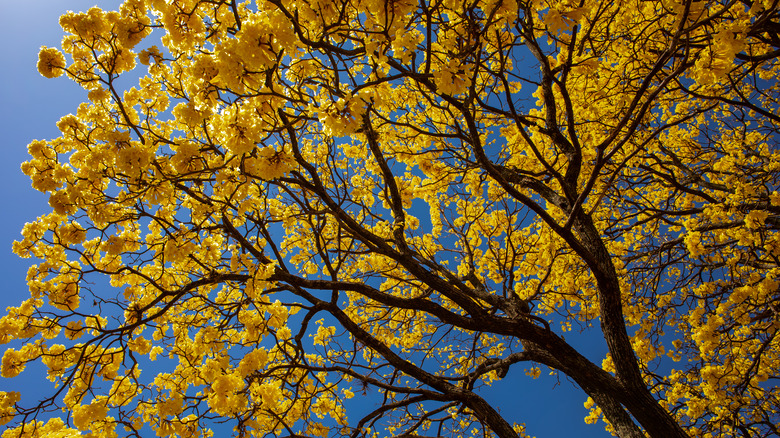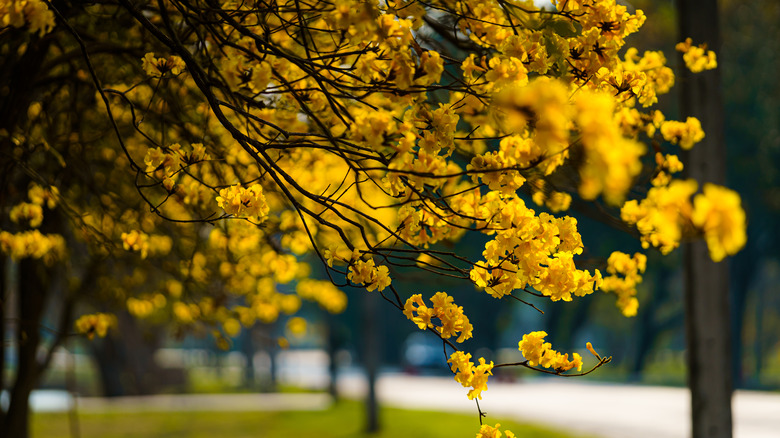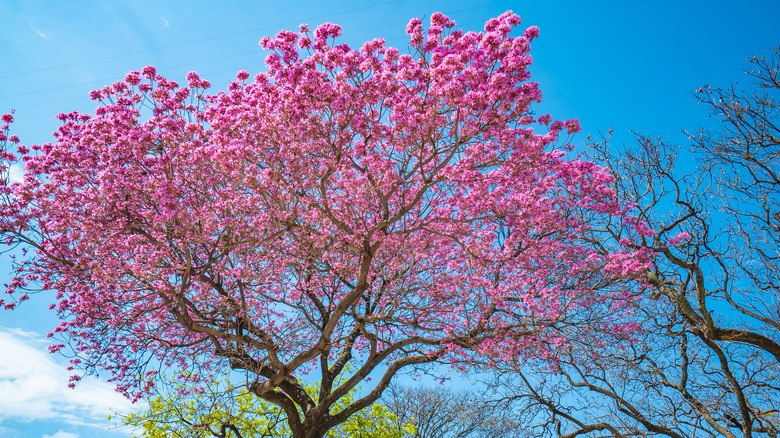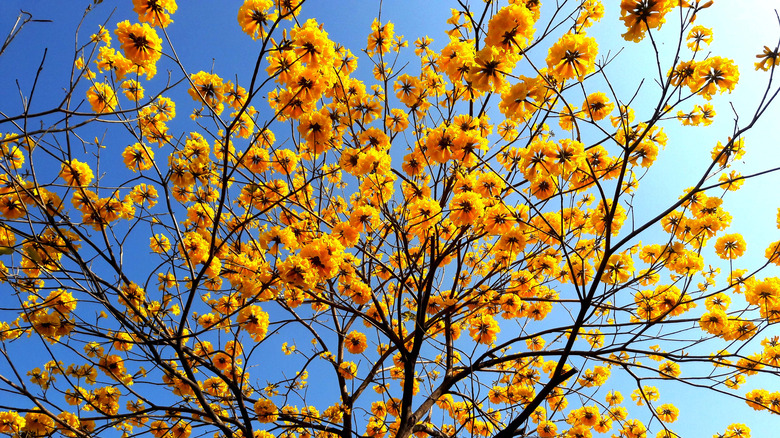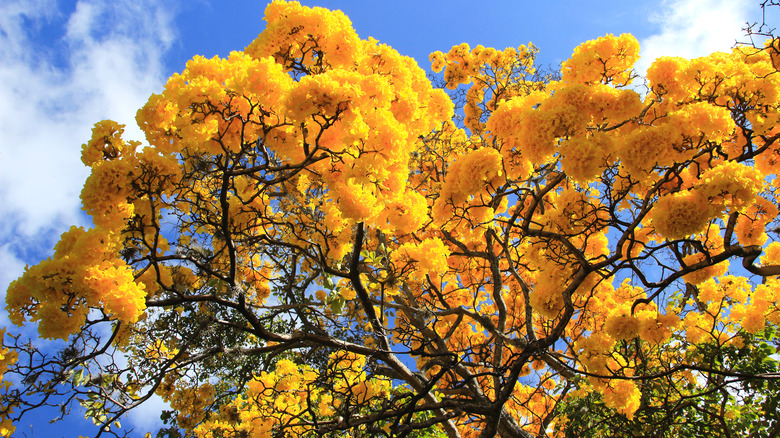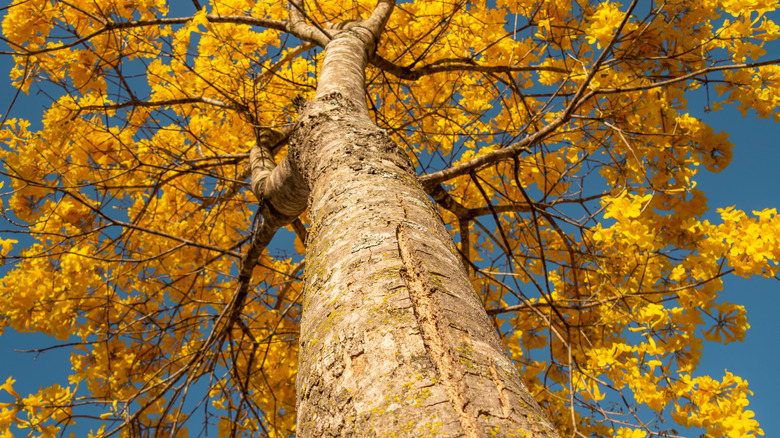How To Care For A Tabebuia Tree
Tabebuia refers to a genus of trees with over 100 species, according to Gardening Know How. They're often referred to as trumpet trees because their blooms are shaped like tubes with ruffled ends, resembling the look of a trumpet. The size and color of the tree depends on the species at hand. Tabebuia trees can grow anywhere from 25 feet to as tall as 160 feet and bloom with gold, pink, purple, white, red, or magenta flowers. The different species also produce different scents, making this a really unique tree with lots of options for growing in your yard.
Native to Central and South America as well as the West Indies, the tabebuia tree is not tolerant to colder climates, only growing in USDA hardiness zones 9b through 11, which includes Southern Florida, the southernmost tip of Texas, and parts of California, as well as most of Hawaii. If you live in a colder climate but still want to grow this tree, keep in mind that the tabebuia tree is difficult to grow indoors because of its size.
How to use tabebuia trees in garden
The tabebuia tree is best grown in warm, tropical to subtropical climates. Make sure these conditions can be matched in your yard before planting the tree. That being said, the tree is remarkably adaptable to a variety of other conditions. Some varieties can even handle light freezes, says Gardening Know How, but don't test your luck too much as a hard freeze will harm the tree. When deciding where to plant the tree in your yard, don't worry too much about different soil conditions, but make sure it'll get partial to full sun.
Tabebuia trees are also pest resistant, which significantly opens up your planting options. For example, tabebuia trees can be planted near crops without the threat of attracting pests. The only spatial concerns to take into consideration, according to South Florida Plant Guide, are planting 15 feet away from your home, 8 to 10 feet away from driveways or walkways, and spacing multiple tabebuias 10 to 12 feet apart.
There are many ways to use the tabebuia tree for landscaping. South Florida Plant Guide recommends using it as a shade tree, an accent in your yard, border your property, or to line a driveway for an arched effect. They also recommend planting shade-tolerant plants under it, including foxtail ferns, variegated arboricolas, and Xanadu philodendrons.
How to plant tabebuia trees
South Florida Plant Guide notes that younger tabebuia trees can be grown in containers. Depending on the variety of tabebuia tree, growing in a container may be somewhat short-lived. With smaller varieties growing as tall as 25 feet, they should not be kept in containers for long. Plant Care Today advises transplanting the trees into the ground once the root system starts outgrowing its container. You'll know this is happening when an excessive amount of roots start growing out of the bottom of the pot or through the top of the soil. The same applies to nursery trees started in containers.
Transplanting should be done in the spring once you notice new growth. To do this, remove the plant from its current container. Then, dig a hole for the tree in your desired location. It can handle pretty much any type of soil, but well-draining soil is ideal. According to Pepper's Home and Garden, the hole should be wide and shallow. Dig the hole to be roughly two to three times wider than the root ball and shallow enough that a couple of inches of the root ball are above the ground. Simply add the plant, refill the soil, and you're done. You can mulch for moisture regulation, and young plants will benefit from either tree stakes or cages.
How to grow tabebuia trees
As with most trees, the tabebuia tree is easiest to grow from a pre-grown nursery plant found at your local garden center or tree nursery. You can also propagate the tree, either from seeds or hardwood cuttings, per Plant Care Today. Both will take lots of patience, but hardwood cuttings are a little more advanced.
Seeds can either be purchased or harvested from a mature tree. They will turn brown in the pods and start to crack, indicating they're ready to be harvested. Fill a pot with potting soil and press the seeds a 1/2 inch into the surface. Keep the soil moist, either through misting or tenting. After four to six weeks, seedlings should start to emerge. Once the plant is roughly 1.5 feet tall, transplant it outdoors.
To obtain a hardwood cutting, look for a mature offshoot that is no shorter than 12 inches long and at least as wide as your finger around the beginning of spring. Carefully remove the bark at the cut end, dip it in a rooting powder, and plant in a 6-inch pot filled with soil. Keep moist, and in eight weeks or so, it should root. Test this by gently tugging on the plant — if it resists, it's rooted. Once your propagation is rooted, you can transplant it outdoors.
How to care for tabebuia trees
Mature tabebuia trees are remarkably low maintenance, making them an ideal tree for your backyard. According to Gardening Know How, they're quite drought resistant, so regular rainfall should suffice. But during long periods without rain, you can give them a small drink. Young or recently transplanted plants, on the other hand, should be thoroughly watered twice a week for two months, advises SFGate.
Fertilizing isn't necessary for blooms — in fact, over-fertilizing mature plants can prevent blooms. A slow-release fertilizer applied once a year in the spring is more than enough for mature trees. Young trees can benefit from fertilizing once every six weeks or so during growing seasons.
Other than that, the only major routine care required by tabebuia trees is regular pruning, both for health and aesthetic purposes. Once the plant enters dormancy, simply prune dead wood and old, brittle branches, as well as any branches that look out of place using sharp, clean pruning shears.
Tabebuia tree varieties
The tabebuia genus includes over 100 species, according to Plant Care Today, with numerous variations in size, color, growth pattern, fragrance, etc. The range of appearance of the flowering tree makes it truly unique. Here are just a few varieties in the expansive genus.
-
Tabebuia caraiba (Silver Trumpet Tree): This species has silver leaves that wonderfully contrast with its golden flowers and thick trunk, according to Gardino Nursery, Corp.
-
Tabebuia pallida (Cuban Pink Trumpet Tree): This tree grows up to 30 feet tall and 25 feet wide, growing bright pink flowers, per University of Florida Gardening Solutions.
-
Tabebuia heterophylla: This species is a semi-deciduous tree that grows pink flowers, growing up to 60 feet tall, and is valued for both its timber and use in floral displays, explains The Useful Tropical Plants Database.
-
Tabebuia argentea (Yellow Trumpet Tree): This variety blooms bright yellow flowers, is related to the Jacaranda tree, and can grow anywhere from 26 to 40 feet tall, per indiaplants.com.
-
Tabebuia impetiginosa (Purple Trumpet Tree): This tree has bright purple, almost pink colored flowers and is sometimes called Pink Ipê or Lavender Trumpet Tree, states Urban Forest Ecosystems Institute at Cal Poly.
Are tabebuia trees toxic?
Sadly, tabebuia trees are poisonous, warns Plant Care Today, who says the plant contains many toxic alkaloids. When ingested, this will result in mild to severe cases of dry mouth, muscle weakness, dilated pupils, or even hallucinations. While the roots, seeds, leaves, and flowers are all poisonous, the seed pods and flowers are the most dangerous and have the most significant adverse effects.
The brighter the flower, the more concentrated the poison is. This is a threat to children in particular, who are often attracted to and curious about the golden or pink blooms. If you have children, be extra careful to warn them about the dangers of the tree, and monitor them if they're outside by it. For the safety of both children and animals, regularly rake up fallen blooms to prevent consumption. If you suspect your child or pet has ingested the plant, call their respective health care provider or local poison control number immediately.
